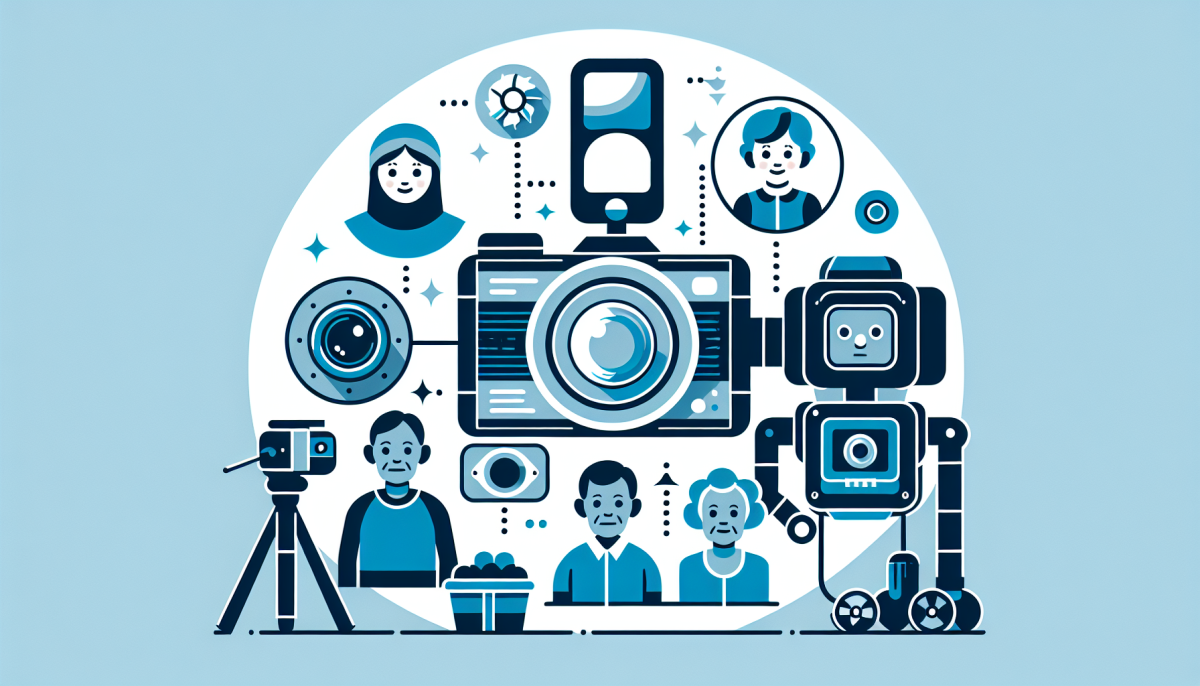Unleashing the power of AI in video creation can feel like harnessing a magic wand capable of crafting content that resonates with a vast array of demographics. Discover how, with these six practical tips, you can adapt, customize, and take your video content creation to new heights—tailored to the beating pulse of each demographic. The significance of “6 Tips for Making Videos for Different Demographics with AI” is to equip marketers and content creators with practical strategies that leverage artificial intelligence to create tailored video content, efficiently targeting and engaging different demographic groups, potentially boosting their audience reach and customer engagement.
Understanding Your Audience Demographics
Recognizing the precise demographic portrait of your audience can spearhead your strategy toward remarkable success. Here, we will elucidate the significance of audience demographics, explore tactics for analyzing demographic data, and discuss how leveraging this data can bolster audience engagement.
Understanding the Importance of Audience Demographics
Understanding the importance of audience demographics plays an integral role in shaping your communication strategies.
These demographics, such as age, gender, education level, and culture, provide valuable insight into your audience’s preferences, behavior patterns, and needs, which directly influence the style, content, and delivery of your message.
For instance, a Generation Z audience may respond more positively to visual and interactive content delivered via social media than Baby Boomers, who may prefer more formal, text-heavy content through traditional media outlets.
Knowledge of these demographics further enables effective segmentation for targeted marketing efforts, enhancing engagement and fostering a more personalized connection.
As a result, applying demographic analysis is an essential step toward creating more impactful, relevant, and successful communication.
- Comprehending the significance of audience demographics is crucial for shaping effective communication strategies.
- Understanding demographic data can help tailor the style, content, and delivery methods of messages to suit audiences’ preferences, behavior patterns, and needs.
- Applying demographic analysis in creating communication channels ensures effective segmentation for targeted marketing, promoting greater engagement and fostering a more personalized connection.
Analyzing Audience Demographics Data
Analyzing audience demographics data plays a pivotal role in tailoring your business strategies for maximum impact and efficacy. The examination of such data yields key insights on variables like age, gender, geographical location, and even lifestyle preferences of your audience, thereby enabling personalized targeting and segmentation.
For example, a renowned fitness chain used demographic data to discover that pockets of their potential customers were concentrated in urban locales and primarily consisted of working professionals aged 25-45. This finding led them to focus their marketing and service offerings for this category.
Consequently, the data-backed approach not only boosted their customer acquisition rates but also improved existing customer retention substantially. Thus, applying thoughtful transitions and logical data analysis, businesses can transform raw demographic data into actionable intelligence for heightened audience engagement and business growth.
- Analyze audience demographics data to tailor business strategies for maximum impact and efficacy.
- Use demographic data findings to personalize targeting and segmentation, adjusting your marketing and service offerings accordingly.
- Apply thoughtful transitions and logical data analysis to turn raw demographic data into actionable intelligence for increasing audience engagement and boosting business growth.
Utilizing Demographics data for better Audience Engagement
Savvy utilization of demographic data can significantly bolster audience engagement. This valuable resource offers insights into age, gender, location, and interests of your target audience, paving the pathway to tailored communication strategies.
For instance, a cosmetics company may find a majority of their audience comprises women aged 20-35 in urban areas. Armed with this information, launching a marketing campaign with youthful, city-centric aesthetics could see increased engagement.
Additionally, recognizing a large segment interested in cruelty-free products could inform branding decisions. Seamless communication targeted to demographic data sets helps foster a deeper connection, increasing the likelihood of audience participation and engagement.
Remember, segmentation is the key, and messages must be customized as per the target group identified through this data.
- Use demographic data for insights into age, gender, location, and interests to tailor communication strategies effectively.
- Identify and understand the interests of specific segments of your audience to inform effective branding and marketing decisions. For instance, a youthful, city-centric aesthetics for a cosmetics company targeting women aged 20-35 in urban areas.
- Customize messages as per the target group identified through demographic data, leveraging segmentation for increased audience participation and engagement.
Utilizing AI for Content Creation
Unlock the latent potential of artificial intelligence in reshaping the content creation sphere as it continues to weave its transformative fingerprints across myriad industries. Dive into the exploration of AI’s functioning in content curation, its prowess in enhancing content writing, and its impact on content strategies, leading the charge toward a more optimized and impactful digital narrative.
Understanding the Role of AI in Content Creation
Understanding the role of AI in content creation is pivotal to harnessing its full potential. Traditionally, content creation has been a manual and labor-intensive process; however, modern AI technologies are revolutionizing this field.
Artificial Intelligence can analyze large swaths of data, recognize patterns, and automate content production, thereby offering the potential to increase efficiency and quality significantly. For example, AI tools such as Natural Language Generation systems can create short news briefs, financial reports, and even sport recaps using structured data.
Even more innovative is the use of AI in suggesting content strategy and topics based on SEO data and trend analysis, ensuring content is not only well written but also well-targeted to gain maximum visibility. This signifies a profound shift, transforming content creation from a linear process into a more dynamic, adaptive, and effective one.
Leveraging AI Tools for Optimized Content Writing
Leveraging AI tools for optimized content writing is a key focus in today’s digital content creation.
AI-based tools such as Articoolo and WordAi offer features that enhance the content creation process by generating human-like text, correcting grammar errors, and analyzing text to achieve optimal SEO capacity.
For example, QuillBot, another AI tool, excels in paraphrasing, helping writers avoid plagiarism and enhance their textual creativity.
Furthermore, companies like Automated Insights and Narrative Science have developed advanced AI tools that can transform raw data into readable reports, ensuring tailored and accurate information.
Thus, the integration of AI tools in content creation contributes significantly to quality enhancement, productivity, and specificity in data presentation.
- Utilize AI-based tools such as Articoolo and WordAi for optimized content creation, which includes features like generating human-like text, correcting grammar errors, and analyzing text for improved SEO.
- Take advantage of AI tools like QuillBot for paraphrasing to avoid plagiarism and enhance textual creativity.
- Incorporate advanced AI tools developed by companies like Automated Insights and Narrative Science that can transform raw data into readable reports for tailored and precise information.
Evaluating and Improving Your Content Strategy with AI
The integral role of AI in evaluating and enhancing your content strategy cannot be overstated. AI-powered tools like MarketMuse and Acrolinx enable content creators to analyze and optimize their content on numerous fronts, from readability and keyword usage to structure and tone.
For instance, MarketMuse leverages AI to provide data-driven recommendations on potential content topics and keyword usage, facilitating more targeted content creation strategies. Acrolinx, on the other hand, focuses on enhancing content quality by recommending improvements in aspects like clarity, tone, and style.
These AI-driven tools help streamline the tedious and often subjective process of content analysis, bringing quantitative measures to the realm of content creation. Therefore, integrating AI in these processes has the potential to yield more precise results, aiding the continual improvement and adaptability of your content strategy.
- Use AI-powered tools such as MarketMuse and Acrolinx to analyze, optimize, and improve your content on various aspects including readability, keyword usage, structure, and tone.
- Leverage MarketMuse for data-driven recommendations on potential content topics and keyword usage to facilitate more targeted content creation strategies.
- Utilize Acrolinx to enhance content quality through recommendations in areas like clarity, tone, and style.
Personalizing Videos for Each Demographic
Perfectly tailored content is no longer a luxury, it’s a necessity, particularly when it comes to designing multimedia. As such, this section delves into the art and science of personalizing videos for different demographic groups, discussing how to comprehend your audience demographics, conceive videos attuned to each demographic and apply personalization methods in video production.
Understanding Your Audience Demographics
The foundation to personalizing videos for each demographic lies in a deep understanding of your audience demographics. Familiarize yourself with valuable data such as age, gender, occupation, location, interests, and lifestyle of your viewers.
For example, a beauty tutorial video might engage more with females in the age group 18-34 who show an interest in makeup and skincare. This specific demographic structuring not only enables you to create tailored content but also helps with effective targeting.
Use this demographic data to shape the content, style, language, and the overall video presentation for resonance and better engagement. Imagine this as speaking the same language as your audience, being culturally sensitive, and directly addressing their needs or interests.
Remember, a strong connection with the audience is key to a more successful video strategy.
Crafting Videos Fitted to Each Demographic
Creating videos tailored to individual demographics requires a careful and strategic approach. It’s crucial to research and understand your target demographic’s cultural, social, and personal preferences to design content that resonates with them.
For instance, if your target audience is millennials, consider incorporating relatable memes, humor and references to pop culture into your content because Statista reports that 40% of this demographic responds positively to such content. Meanwhile, videos aimed at older adults might benefit from a slower pace, clear instructions, and a focus on traditional values, as the PEW Research Center has found that this demographic tends to appreciate comprehensive and respectful content.
Crafting videos suited to each audience isn’t merely about changing aesthetics; it requires adjusting language, tone, pacing, and content to maintain viewer engagement and deliver a personalized experience. Remember, the goal is to create content that looks like it’s speaking directly to each viewer, no matter their demographic.
- Research and understand the cultural, social, and personal preferences of the target demographic to design content that resonates with them.
- Incorporate elements into the video content that the specific demographic responds positively to, such as memes, humor and pop culture references for millennials and a slower pace, clear instructions, and traditional values for older adults.
- Adjust the language, tone, pacing, and content to maintain viewer engagement and deliver a personalized experience, creating the impression of content that speaks directly to each viewer.
Using Personalization Techniques in Video Creation
Utilizing personalization techniques when creating videos is an effective way to engage an audience. Personalization involves tailoring content to the unique needs and preferences of different demographic groups.
For example, animations or vibrant colors may be more appealing to younger viewer groups, while mature audiences might appreciate documentary-style presentations or in-depth discussions. A 2020 study by Epsilon found that 80% of customers are more inclined to do business with a company that personalizes their experiences.
In addition, including personalized messages or content segments may boost viewer engagement rates. Understanding your target demographic’s interests, preferences, and viewing habits is key to successful video personalization.
Seamless transitions between personalized elements can be created through the use of storyboarding and strategic scripting, ensuring a smooth viewer experience.
- Implement personalization techniques when creating videos to tailor content to different demographic groups’ needs and preferences, such as using animation and vibrant colors for younger viewers or documentary-style presentations for mature viewers.
- Include personalized messages or content segments to increase viewer engagement rates. This requires understanding your target demographic’s interests, preferences, and viewing habits.
- Create seamless transitions between personalized elements through the use of storyboarding and strategic scripting, ensuring a smooth viewer experience.
Continuously Improving Your Videos Using AI Feedback
Harnessing AI-enhanced feedback for video production not only enhances visual content, but it also paves the way to create more targeted, captivating and personalized viewer experiences. This section will dissect and explore the essence of AI feedback, its implementation for optimizing video content, and how strategic adjustments based on AI feedback can cement your videos’ continual improvement.
Understanding AI Feedback and Its Importance
Understanding AI feedback takes center stage in ensuring video content improvement.
Artificial Intelligence (AI) feedback systems are highly accurate and provide detailed insights into multiple aspects of your video, for example, identifying parts that captivate viewers and those that push them away.
For instance, YouTube’s AI algorithm provides feedback on watch time, audience retention, and viewer engagement, presenting content creators with valuable data to produce enhanced, audience-tailored videos.
Thus, comprehending AI feedback is crucial in the continuous process of video improvement as it directs creators to where they need enhancements in their content, ultimately leading to better viewer satisfaction and increased engagement rates.
Implementing Changes Based on AI Feedback
Implementing changes based on AI feedback is a crucial step in continuously improving your video content quality. This process involves analyzing data retrieved from AI tools, which examine numerous factors such as viewer engagement, video structure, and graphics effectiveness.
For instance, if AI feedback indicates lower viewer engagement during certain parts of your video, consider re-evaluating those segments’ script, visuals, or duration. Similarly, if your video structure does not align with those that perform well, applying changes, such as adding a compelling introduction or call-to-action, can significantly enhance your video’s performance.
Smooth transitions between revised segments, achieved using transitional words or phrases, can ensure a seamless viewing experience. By being responsive to AI feedback and promptly implementing changes, you can substantially boost the quality and effectiveness of your video content.
- Analyze data from AI tools to identify areas of improvement in your video content, focusing on viewer engagement, video structure, and graphics effectiveness.
- Apply changes based on AI feedback to enhance video performance. This could include revising the script, visuals, or duration of segments with lower viewer engagement or adding a compelling introduction or call-to-action where necessary.
- Ensure smooth transitions between revised segments using transitional words or phrases for a seamless viewing experience. Be responsive to AI feedback and implement changes promptly to boost video quality and effectiveness.
Tracking Improvements and Adjusting Strategies
Continuous growth and enhancement of your video content is possible through accurate tracking of improvements and strategic adjustments based on AI feedback.
Harnessing advanced AI analysis, one can collect vital metrics such as audience engagement, watch times, and social shares, giving a concrete foundation for evaluating your content’s performance.
For instance, an unexpected drop in audience engagement could imply the need for a more compelling introduction or the inclusion of graphics for better visual appeal.
AI also provides valuable insights concerning viewer preferences and demographic characteristics, enabling you to adjust your content delivery strategies.
A smooth transition to this data-informed strategy aids in fostering consistency, remaining relevant, and ultimately elevating your video content quality.
- Utilizing AI analysis to track improvements and strategic adjustments in video content allows continuous growth and enhancement.
- Use the collected vital metrics such as audience engagement, watch times, and social shares to evaluate your content’s performance and make necessary adjustments.
- Incorporate the valuable insights extracted by AI concerning viewer preferences and demographic characteristics to maintain consistency, remain relevant, and improve the quality of your video content.
Frequently Asked Questions
How does understanding audience demographics improve content creation?
Comprehensive knowledge of audience demographics equips content creators with insight into the preferences, behavior patterns, and needs of the audience. It allows tailoring of style, content, and delivery methods of messages to suit this audience, resulting in a more effective communication. Furthermore, demographic analysis enables effective segmentation for targeted marketing efforts, promoting greater engagement and fostering a more personalized connection.
Why is analyzing audience demographics data important?
Analyzing audience demographics data allows business strategies to be tailored for maximum impact and efficacy. It provides key insights on variables like age, gender, geographical location, and lifestyle preferences of the audience, aiding personalized targeting and segmentation. This examination of data and the resulting data-backed approach boosts customer acquisition rates and improves customer retention substantially.
What is the role of AI in content creation?
AI plays a significant role in reshaping content creation. By analyzing large swaths of data, recognizing patterns, and automating content production, AI has the potential to increase the efficiency and quality of content creation significantly. Additionally, AI can suggest content strategies and topics based on SEO data and trend analysis, ensuring content is well-targeted to gain maximum visibility.
How can AI tools optimize content writing?
AI tools such as Articoolo and WordAi can generate human-like text, correct grammar errors, and analyze text to achieve optimal SEO capacity, enhancing content creation. Further AI tools can transform raw data into readable reports, ensuring tailored and accurate information. The incorporation of AI in content creation contributes significantly to the enhancement of quality and productivity.
How can videos be personalized for each demographic?
Videos can be personalized by understanding the audience demographics and crafting the content, style, language, and overall video presentation to resonate better with them. This requires a careful and strategic approach to research and understand the demographic’s cultural, social, and personal preferences and incorporate elements to which such demographics respond positively. The delivery, language, and content should be adjusted to maintain viewer engagement, giving the impression of content that speaks directly to each viewer.
What is the role of AI feedback in improving videos?
AI feedback systems provide highly accurate and detailed insights into multiple aspects of video content, identifying captivating and off-putting parts of it. It plays a crucial role in improving video quality and directing creators where enhancements are needed, leading to better viewer satisfaction and increased engagement rates.
How can AI feedback be used to implement changes in videos?
Changes based on AI feedback involve analyzing data retrieved from AI tools, which examine factors such as viewer engagement, video structure, and graphics effectiveness. Any identified areas of improvement can be adjusted, with elements such as a compelling introduction or call-to-action added as necessary, ensuring increased effectiveness of the video.
How can improvements be tracked and strategies adjusted using AI?
Advanced AI analysis collects vital metrics such as audience engagement, watch times, and social shares, providing a solid foundation for evaluating content performance. AI insights about viewer preferences and demographic characteristics allow content delivery strategies to be adjusted. This ability to track improvements and make informed adjustments fosters consistency, relevance, and overall quality of video content.









